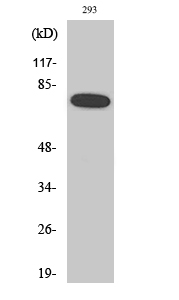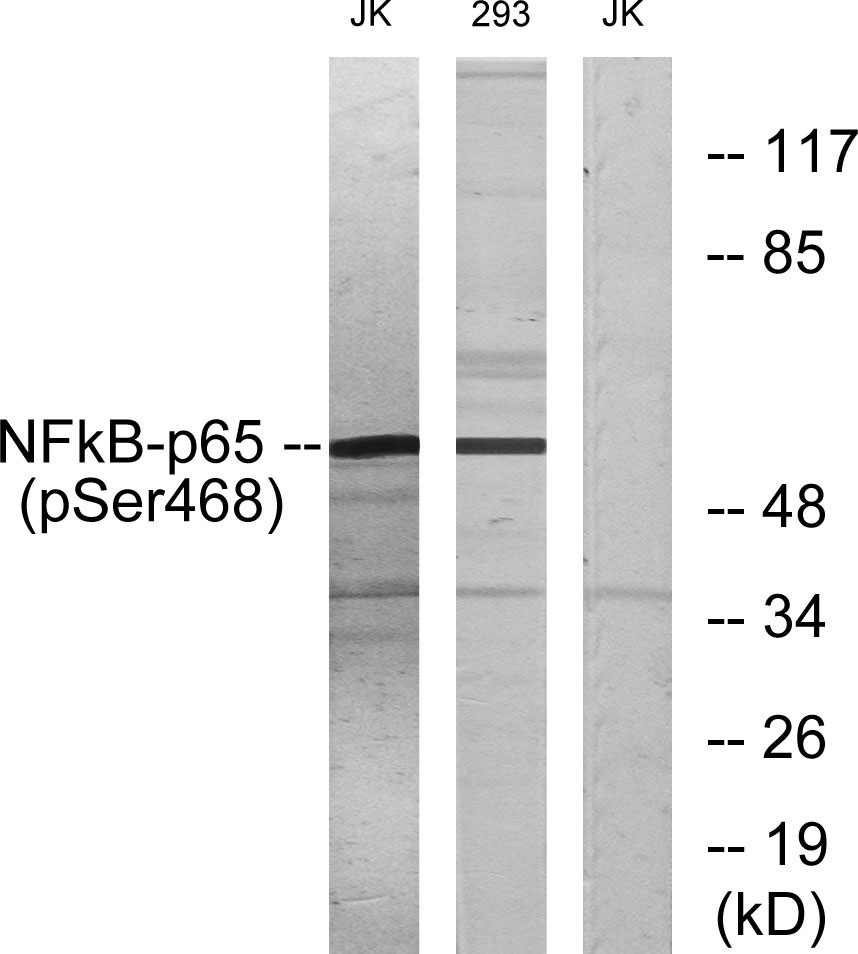NFκB-p65 (phospho Ser468) Polyclonal Antibody
- Catalog No.:YP0188
- Applications:WB;IHC;IF;IP;ELISA
- Reactivity:Human;Mouse;Rat;Pig
- Target:
- NFkB p65
- Fields:
- >>Antifolate resistance;>>MAPK signaling pathway;>>Ras signaling pathway;>>cAMP signaling pathway;>>Chemokine signaling pathway;>>NF-kappa B signaling pathway;>>HIF-1 signaling pathway;>>Sphingolipid signaling pathway;>>Mitophagy - animal;>>PI3K-Akt signaling pathway;>>Apoptosis;>>Longevity regulating pathway;>>Cellular senescence;>>Osteoclast differentiation;>>Neutrophil extracellular trap formation;>>Toll-like receptor signaling pathway;>>NOD-like receptor signaling pathway;>>RIG-I-like receptor signaling pathway;>>Cytosolic DNA-sensing pathway;>>C-type lectin receptor signaling pathway;>>IL-17 signaling pathway;>>Th1 and Th2 cell differentiation;>>Th17 cell differentiation;>>T cell receptor signaling pathway;>>B cell receptor signaling pathway;>>TNF signaling pathway;>>Neurotrophin signaling pathway;>>Prolactin signaling pathway;>>Adipocytokine signaling pathway;>>Relaxin signaling pathway;>>Insulin resistance;>>Non-alcoholic fatty liver disease;>>AGE-RAGE signaling pathway in diabe
- Gene Name:
- RELA
- Protein Name:
- Transcription factor p65
- Human Gene Id:
- 5970
- Human Swiss Prot No:
- Q04206
- Mouse Gene Id:
- 19697
- Mouse Swiss Prot No:
- Q04207
- Immunogen:
- The antiserum was produced against synthesized peptide derived from human NF-kappaB p65 around the phosphorylation site of Ser468. AA range:435-484
- Specificity:
- Phospho-NFκB-p65 (S468) Polyclonal Antibody detects endogenous levels of NFκB-p65 protein only when phosphorylated at S468.
- Formulation:
- Liquid in PBS containing 50% glycerol, 0.5% BSA and 0.02% sodium azide.
- Source:
- Polyclonal, Rabbit,IgG
- Dilution:
- WB 1:500 - 1:2000. IHC 1:100 - 1:300. Immunoprecipitation: 2-5 ug:mg lysate. ELISA: 1:20000.. IF 1:50-200
- Purification:
- The antibody was affinity-purified from rabbit antiserum by affinity-chromatography using epitope-specific immunogen.
- Concentration:
- 1 mg/ml
- Storage Stability:
- -15°C to -25°C/1 year(Do not lower than -25°C)
- Other Name:
- RELA;NFKB3;Transcription factor p65;Nuclear factor NF-kappa-B p65 subunit;Nuclear factor of kappa light polypeptide gene enhancer in B-cells 3
- Observed Band(KD):
- 60kD
- Background:
- NF-kappa-B is a ubiquitous transcription factor involved in several biological processes. It is held in the cytoplasm in an inactive state by specific inhibitors. Upon degradation of the inhibitor, NF-kappa-B moves to the nucleus and activates transcription of specific genes. NF-kappa-B is composed of NFKB1 or NFKB2 bound to either REL, RELA, or RELB. The most abundant form of NF-kappa-B is NFKB1 complexed with the product of this gene, RELA. Four transcript variants encoding different isoforms have been found for this gene. [provided by RefSeq, Sep 2011],
- Function:
- function:NF-kappa-B is a pleiotropic transcription factor which is present in almost all cell types and is involved in many biological processed such as inflammation, immunity, differentiation, cell growth, tumorigenesis and apoptosis. NF-kappa-B is a homo- or heterodimeric complex formed by the Rel-like domain-containing proteins RELA/p65, RELB, NFKB1/p105, NFKB1/p50, REL and NFKB2/p52 and the heterodimeric p65-p50 complex appears to be most abundant one. The dimers bind at kappa-B sites in the DNA of their target genes and the individual dimers have distinct preferences for different kappa-B sites that they can bind with distinguishable affinity and specificity. Different dimer combinations act as transcriptional activators or repressors, respectively. NF-kappa-B is controlled by various mechanisms of post-translational modification and subcellular compartmentalization as well as by in
- Subcellular Location:
- Nucleus . Cytoplasm . Nuclear, but also found in the cytoplasm in an inactive form complexed to an inhibitor (I-kappa-B) (PubMed:1493333). Colocalized with DDX1 in the nucleus upon TNF-alpha induction (PubMed:19058135). Colocalizes with GFI1 in the nucleus after LPS stimulation (PubMed:20547752). Translocation to the nucleus is impaired in L.monocytogenes infection (PubMed:20855622). .
- Expression:
- Bone,Colon,Pancreas,Placenta,
Chronic glucocorticoids exposure enhances neurodegeneration in the frontal cortex and hippocampus via NLRP-1 inflammasome activation in male mice. BRAIN BEHAVIOR AND IMMUNITY Brain Behav Immun. 2016 Feb;52:58 WB Mouse frontal cortex , hippocampus
Sacubitril/Valsartan Alleviates Experimental Autoimmune Myocarditis by Inhibiting Th17 Cell Differentiation Independently of the NLRP3 Inflammasome Pathway. Frontiers in Pharmacology Front Pharmacol. 2021; 12: 727838 WB Mouse 1:1000 Myocardial tissues
CD137 Signaling Promotes Endothelial Apoptosis by Inhibiting Nrf2 Pathway, and Upregulating NF-κB Pathway. MEDIATORS OF INFLAMMATION Mediat Inflamm. 2020;2020:4321912 WB Human 1 : 1000 HUVECs
The antitumor effect of hinesol, extract from Atractylodes lancea (Thunb.) DC. by proliferation, inhibition, and apoptosis induction via MEK/ERK and NF‐κB pathway in non–small cell lung cancer cell lines A549 and NCI‐H1299. JOURNAL OF CELLULAR BIOCHEMISTRY 2019 Jul 24 WB Human A549 cell
Soybean Glycinin- and β-Conglycinin-Induced Intestinal Damage in Piglets via the p38/JNK/NF-κB Signaling Pathway. JOURNAL OF AGRICULTURAL AND FOOD CHEMISTRY J Agr Food Chem. 2018;66(36):9534–9541 WB Pig 1:1000 small intestine
Rhein protects against barrier disruption and inhibits inflammation in intestinal epithelial cells. INTERNATIONAL IMMUNOPHARMACOLOGY Int Immunopharmacol. 2019 Jun;71:321 WB Rat IEC-6 cell
CD137 Regulates NFATc1 Expression in Mouse VSMCs through TRAF6/NF-κB p65 Signaling Pathway. MEDIATORS OF INFLAMMATION Mediat Inflamm. 2015;2015:639780 WB Mouse 1 : 1000 VSMCs
- June 19-2018
- WESTERN IMMUNOBLOTTING PROTOCOL
- June 19-2018
- IMMUNOHISTOCHEMISTRY-PARAFFIN PROTOCOL
- June 19-2018
- IMMUNOFLUORESCENCE PROTOCOL
- September 08-2020
- FLOW-CYTOMEYRT-PROTOCOL
- May 20-2022
- Cell-Based ELISA│解您多样本WB检测之困扰
- July 13-2018
- CELL-BASED-ELISA-PROTOCOL-FOR-ACETYL-PROTEIN
- July 13-2018
- CELL-BASED-ELISA-PROTOCOL-FOR-PHOSPHO-PROTEIN
- July 13-2018
- Antibody-FAQs
- Products Images

- Western Blot analysis of various cells using Phospho-NFκB-p65 (S468) Polyclonal Antibody diluted at 1:1000

- Immunohistochemistry analysis of paraffin-embedded human breast carcinoma, using NF-kappaB p65 (Phospho-Ser468) Antibody. The picture on the right is blocked with the phospho peptide.

- Western blot analysis of lysates from Jurkat cells and 293 cells, using NF-kappaB p65 (Phospho-Ser468) Antibody. The lane on the right is blocked with the phospho peptide.



